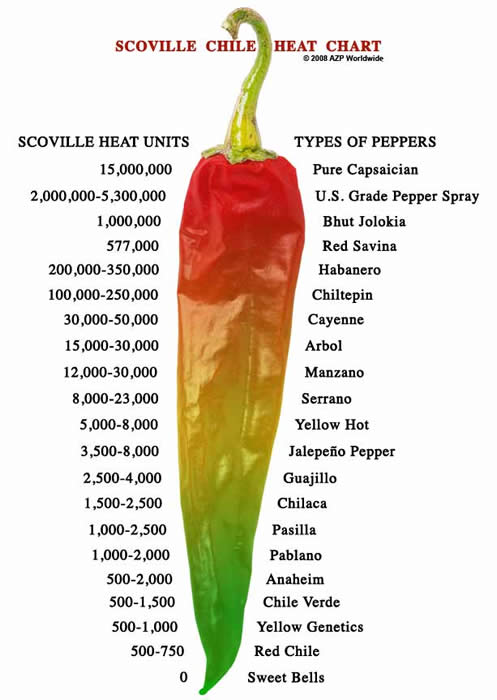If you are a chile eater, you have probably seen or heard of the Scoville Chile Heat Chart. The Scoville scale measures the hotness of a chili pepper, as defined by the amount of capsaicin (a chemical compound that stimulates nerve endings in the skin) present. In other words the amount of burn you are going to feel. The scale is named after its an American chemist named Wilbur Scoville. He developed a test for rating the pungency of chiles.
(If you'd like to learn more about this test, click here)

I found this chart on a great website called Eat More Chilies. Apparently the site grew from one chile pepper writing assignment in Arizona to a huge chile handbook. There are recipes, event info and a lot of chile facts. Some of which I thought quite interesting:
Did you know...?
• Chiles are healthy! They are low in sodium and calories and are cholesterol free. Chilis are a good source of vitamins A, B, C, and E, folic acid, and potassium.
• Eating chiles can help with digestion. The capsaicin in chiles increases gastric secretions and the flow of saliva, combining to ease the digestion process.
• In 2007, salsa surpassed ketchup as the most widely used condiment in the United States.
• A Chile’s heat or intensity is commonly, but incorrectly, said to come from the seeds in the chili. The heat actually comes from capsaicinoids - the combination of capsaicin (the active component of a chile) and a few other related chemicals - that is found along placental tissue in the center of the chile where the seeds are found.
• The color of a chili pepper actually has nothing to do with its heat level. Rather, the color typically signifies the maturity of the fruit.
• Birds are not affected by the heat or pungency of capsaicin because they do not have a receptor to detect it. This allows capsicum plant seeds to be dispersed through avian travel.



No comments:
Post a Comment
Hola! I love to reading your comments. Thanks for visiting Viva la Cocina!